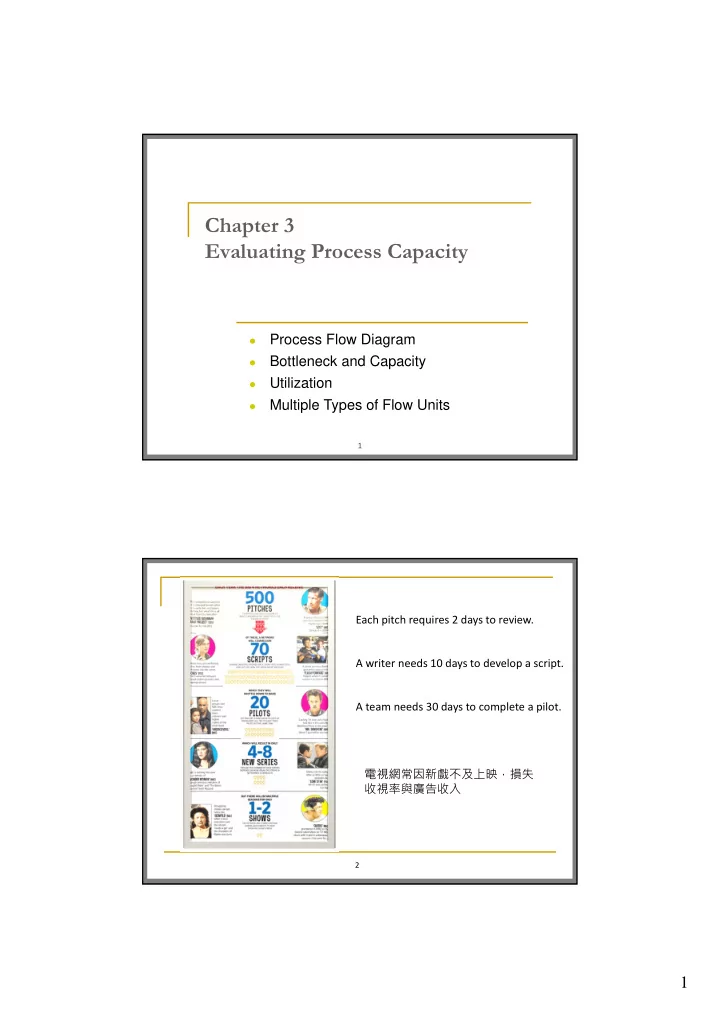

Chapter 3 Evaluating Process Capacity Process Flow Diagram Bottleneck and Capacity Utilization Multiple Types of Flow Units 1 Each pitch requires 2 days to review. A writer needs 10 days to develop a script. A team needs 30 days to complete a pilot. 電視網常因新戲不及上映,損失 收視率與廣告收入 2 1
Processes with Attrition Loss 2 70 20 6 500 ideas per year New 2nd Pitches Scripts Pilots Series season Processing time 2 days 10 days 30 days 70 days 200 days Resources 5 3 2 2 1 250 days judges script writers pilot teams series crews main crew per year Where is the Bottleneck? 3 Basic Process Vocabulary For each step of the process Activity times : how long does an operation (step) take? Capacity : number of flow units processed per unit of time. For the entire process Bottleneck : operation (step) with the lowest capacity Process capacity : capacity of the bottleneck Flow rate : rate at which flow units flow through the process Utilization =Flow Rate / Capacity Flow Time : amount of time it takes to go through the process 4 2
3.1 The Circored Plant converts iron ores into iron briquettes to supply steel plants 5 How to Draw a Process Flow Diagram Focus on one or two types of flow units. Define the process boundaries and choose an appropriate level of detail. Include only those steps that are likely to affect the process flow or the economics of the process. Sizes and exact locations of arrows, boxes, and triangles do not carry any special meaning. Use different colors for different routes. Stay closer to the physical layout. 6 3
Complete Process Flow Diagram 7 3.2 Resource and Process Capacity How much a resource can serve in a given unit of time? Design Capacity maximum amount of output w/o constraints Effective Capacity maximum amount of output under maintenance, quality, and human constraints Best Operating Level level of capacity at which average unit cost is minimized. 8 4
Multiple Resources/Servers Activity time = T time units � Capacity of a single server = � units per time unit If a step has m identical servers in parallel � Capacity = � units per time unit � Output 1 unit every � time units 9 Bottleneck and Process Capacity Process capacity is determined by the resource with the smallest capacity. Flow rate = min{ available input, process capacity, demand } input capacity demand input capacity demand input capacity demand 10 5
Finding the Bottleneck in a Process Stationary reactor WIP 400 tons Stationary reactor capacity 100 tons/hour flow time 4 hours 11 Example: Bread Making and Packing 12 6
3.3 Time to Process a Certain Amount of Supply Assuming the process is already producing output X Time to serve X units = flow rate If the process starts empty X ‐ 1 Time to serve X units = total processing time + flow rate Improving the bottleneck Reducing time to serve X units 13 3.4 Process Utilization and Capacity Utilization flow rate Process Utilization = process capacity flow rate Resource Utilization = resource capacity The objective of most businesses is to increase profit, not to increase utilization. 14 7
Utilization with limited demand Assume the demand is only 657,000 tons. The bottleneck is the resource with the highest utilization. 15 3.5 Workload and Implied Utilization Utilization only carries information about excess capacity. Implied utilization captures the mismatch when the demand exceeds the capacity. 16 8
Service Example: Driver’s License Office 1 2 3 4 5 6 Check Process Check for Conduct Photograph Issue new application payment violations eye test applicant license 15 sec. 30 sec. 60 sec. 40 sec. 20 sec. 30 sec. The office has 6 clerks, one for each step. The current capacity is 60 applicants per hour. It is under pressure to increase its productivity to process 120 applicants per hour with the addition of only one clerk. Can rearrange steps 2 ‐ 4 in any order. 17 3.6 Multiple Types of Flow Units The flow may break up into multiple flows. Different types of flow units move through the process. 18 9
Bottleneck in the Multiproduct Process The product mix affects the process capacity. Not all activities are required by all product type. 19 Economy of Scale As the plant gets larger and production volume increases, the plant can fully utilize dedicated resources and thus reduce unit cost and selling price. Larger Plant Lower Cost Lower Price More Market Share Economy of Scale will backfire and incur huge loss if demand cannot match capacity. The size of a plant may become too large and management, material handling, or maintenance become a serious problem. 20 10
Economy of Scale for Service Industry Chain stores lead to buying power. Travel agencies buy airline tickets and hotel rooms in bulks to get deeper discount. Small business can form an alliance to increase the bargaining power against big suppliers. Competing retail stores or restaurants located in the same area may attract more consumers. 瑞豐 night market 21 Summary World class enterprises excel at the speedy and flexible integration of the business processes. Finding the bottleneck is the key to improve a variety of performance measures. 22 11
Recommend
More recommend